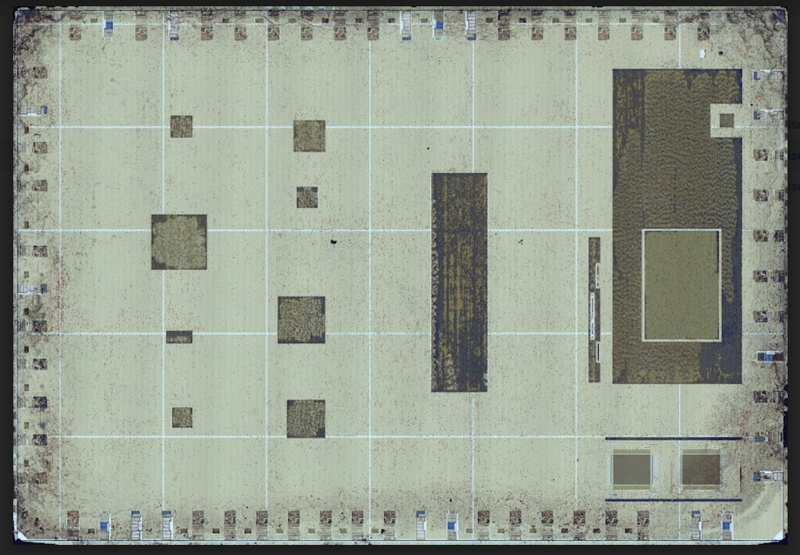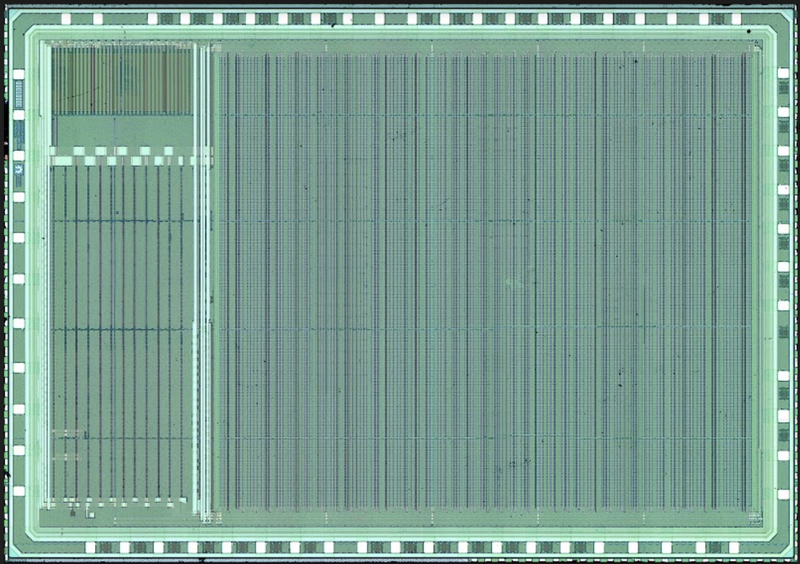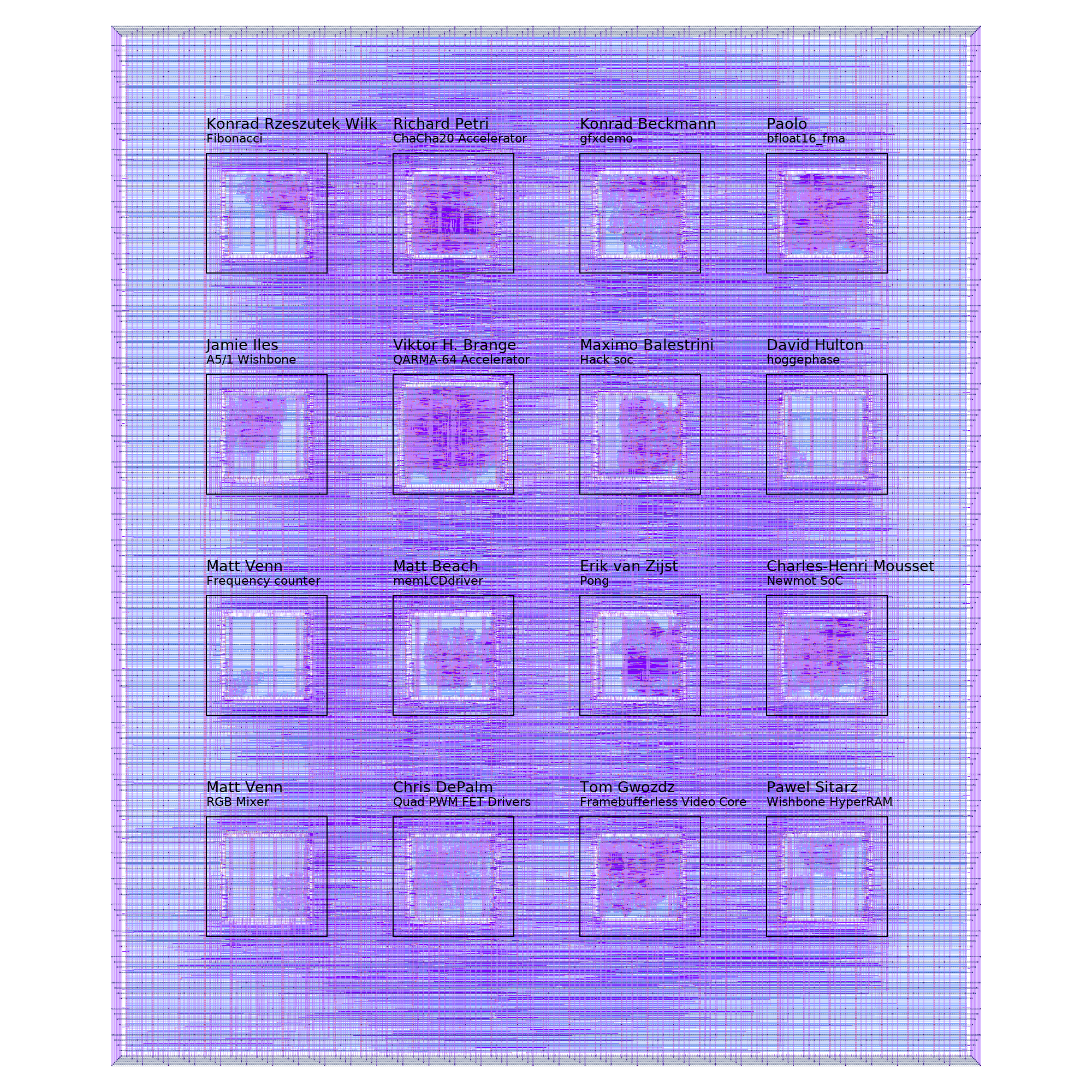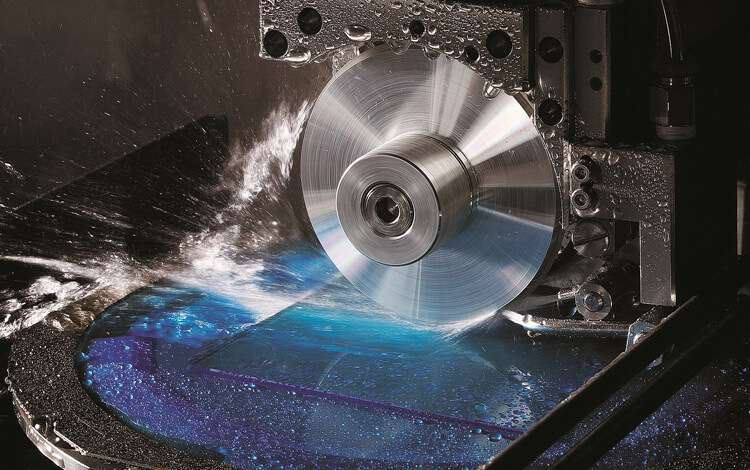

 good day!
good day!
 Hi Matt! Welcome aboard!
Hi Matt! Welcome aboard!
 RPG map ?
RPG map ?
 if you are 5nm tall, yes!
if you are 5nm tall, yes!
![]() This looks like his MPW1 layout
This looks like his MPW1 layout
 yup
yup
 It's the new zombie map in Call of Duty
It's the new zombie map in Call of Duty
 yeah it's got that ragged look
yeah it's got that ragged look
 this is with top metal removed, which isn't a perfect process
this is with top metal removed, which isn't a perfect process
 otherwise it looks like this
otherwise it looks like this


 spreadsheet mode
spreadsheet mode
 Welcome one and all, let's get started! I'm Dan, I'll be modding today with Dusan as we welcome Matt Venn to the Hack Chat to talk about open-source ASICs and spinning up your own silicon.
Welcome one and all, let's get started! I'm Dan, I'll be modding today with Dusan as we welcome Matt Venn to the Hack Chat to talk about open-source ASICs and spinning up your own silicon.
Hi Matt! I know you've been around HaD quite a bit, but care to tell us a bit more about yourself?
 Funny that they look so different
Funny that they look so different
 hi everyone
hi everyone
 hi
hi
 yes I've been doing electronics for a long time
yes I've been doing electronics for a long time
 when I was a kid I bought maplin kits and assembled them, but didn't know how they worked
when I was a kid I bought maplin kits and assembled them, but didn't know how they worked
I built a door lock that used some recycled 7 seg displays, and I hard wired them to spell 'open' when on, and nothing when off
 had no idea about how you would actually count numbers or change text!
had no idea about how you would actually count numbers or change text!
 learnt slowly, got into microcontrollers, then fpgas
learnt slowly, got into microcontrollers, then fpgas
 got involved with yosyshq and the formal verification tools
got involved with yosyshq and the formal verification tools
 open source fpga toolchains
open source fpga toolchains
 i was at week of open source hardware (WOSH)
i was at week of open source hardware (WOSH)
when I saw Tim EDwards from Efabless showing a chip made with open source tools
 so I downloaded them and tried them on an fpga design (the vga clock)
so I downloaded them and tried them on an fpga design (the vga clock)
 I looked at running a course so I could tape-out, but the cost was about 10k,
I looked at running a course so I could tape-out, but the cost was about 10k,
 so I canned it. then 6 months later Tim Ansell announced the free shuttle program
so I canned it. then 6 months later Tim Ansell announced the free shuttle program
 so I was in a good place and time to jump on and ride the wave
so I was in a good place and time to jump on and ride the wave
 now I have 4 tapeouts and preparing for my 5th
now I have 4 tapeouts and preparing for my 5th
 160 people have taken my course and about 40 have taped out
160 people have taken my course and about 40 have taped out
 mpw5 tapes out on Monday, so I'm getting things ready for that at the moment
mpw5 tapes out on Monday, so I'm getting things ready for that at the moment
![]() what is the process size?
what is the process size?
 130nm, which is a kind of hybrid I think. The gate width of the standard cell library are 150nm
130nm, which is a kind of hybrid I think. The gate width of the standard cell library are 150nm
![]() that would be ~1.2V?
that would be ~1.2V?


 1.8v core
1.8v core
![]() Can you talk about what sort of FPGA designs can be easily ported? And what's harder coming from an FPGA?
Can you talk about what sort of FPGA designs can be easily ported? And what's harder coming from an FPGA?
 the easiest is pure digital with no hard ip blocks like multiplies or brams
the easiest is pure digital with no hard ip blocks like multiplies or brams
 you can synthesise small memories with yosys out of flip flops but they are big and don't scale well
you can synthesise small memories with yosys out of flip flops but they are big and don't scale well
we have openram for some hard sram blocks, 1kb in size
![]() And what if we wanted to multiply - just let it synthesize it?
And what if we wanted to multiply - just let it synthesize it?
 you could easly build a multiplier as well, for a dsp block but it would probably be quite big and not as efficient as one you'd get on an ecp5 for example
you could easly build a multiplier as well, for a dsp block but it would probably be quite big and not as efficient as one you'd get on an ecp5 for example
 yeah
yeah
 try not to divide!
try not to divide!
![]() Right, that's true on FPGAs too
Right, that's true on FPGAs too
![]() Can you give an idea of what sort of timing / frequency can be had?
Can you give an idea of what sort of timing / frequency can be had?
![]() The MPW has 16 slots of 300x300 um areas. Have any of the 160 been too constrained by this for their circuit design?
The MPW has 16 slots of 300x300 um areas. Have any of the 160 been too constrained by this for their circuit design?
 so you can do ghz no probs
so you can do ghz no probs
 but we have limited bw on the ios, they are quite old and only really go up to 50mhz
but we have limited bw on the ios, they are quite old and only really go up to 50mhz
![]() 300um x 300um or 800um x 800um max size - roughly how many pads and how many gates is realistic?
300um x 300um or 800um x 800um max size - roughly how many pads and how many gates is realistic?
 there is an 'analog' version of the submission process that gives you 11 pads with no io pad, so you would have to deal with drive current, esd protection etc yourself, but then you could get ghz in and out of the chip. and it's wlcsp so quite good for high frequency
there is an 'analog' version of the submission process that gives you 11 pads with no io pad, so you would have to deal with drive current, esd protection etc yourself, but then you could get ghz in and out of the chip. and it's wlcsp so quite good for high frequency
![]() How does that work if you only have 50 MHz in - are there PLLs you can design in?
How does that work if you only have 50 MHz in - are there PLLs you can design in?
 James, that's actually just what I do for my group submissions
James, that's actually just what I do for my group submissions
 so it's a sort of IP/block for the IOs and the design of that is what limits the I/O frequency off the chip?
so it's a sort of IP/block for the IOs and the design of that is what limits the I/O frequency off the chip?

https://www.zerotoasiccourse.com/post/mpw2-submitted/
MPW2 Submitted
We did it! 14 people from the course got their designs into the group submission, and the project was accepted for fabrication. Silicon here we come! You can get all the details on all the projects from the Efabless submission And see how I put the application together here.
Read this on Zero to ASIC Course
 the full area is 3000 x 3600 um
the full area is 3000 x 3600 um
 there are 40 slots on the free shuttle
there are 40 slots on the free shuttle
 I started off applying for 1 each on mpw1 and 2 but from 3 onwards I am putting more on
I started off applying for 1 each on mpw1 and 2 but from 3 onwards I am putting more on
![]() What can you tell us about that frequency counter on there?
What can you tell us about that frequency counter on there?
 Ian, yes it's old io inheritted from cypress
Ian, yes it's old io inheritted from cypress
 Tom, it's a very simple design I made to teach basic digital design to people who haven't touched digital design before
Tom, it's a very simple design I made to teach basic digital design to people who haven't touched digital design before
 edge detecter, counter, 7 seg driver
edge detecter, counter, 7 seg driver
![]() Are each of the designs driven by the PicoRV32 core or are they attached directly to package I/O?
Are each of the designs driven by the PicoRV32 core or are they attached directly to package I/O?
 Do you know how things are looking on the analog side for these shuttles now? I started looking at the very start and it was very rough with untrustworthy models. Has this improved?
Do you know how things are looking on the analog side for these shuttles now? I started looking at the very start and it was very rough with untrustworthy models. Has this improved?

https://github.com/mattvenn/frequency_counter
GitHub - mattvenn/frequency_counter
You can't perform that action at this time. You signed in with another tab or window. You signed out in another tab or window. Reload to refresh your session. Reload to refresh your session.
 If you only have 50 MHz in - are there PLLs you can design in?
If you only have 50 MHz in - are there PLLs you can design in?
 the picorv32 is a coprocessor. it loads the gpio configuratoin and then you can ignore it. but you could add some wishbone peripheral for example and use it to accelerate the pico
the picorv32 is a coprocessor. it loads the gpio configuratoin and then you can ignore it. but you could add some wishbone peripheral for example and use it to accelerate the pico
 I usually attach my designs to the output/input pins
I usually attach my designs to the output/input pins
![]() I'm not familiar with wishbone peripherals
I'm not familiar with wishbone peripherals
 and to handle multiple designs; on mpw1 I used a big mux (the big rectangle in the first pic I posted), and for mpw2 onwards used tristate outputs
and to handle multiple designs; on mpw1 I used a big mux (the big rectangle in the first pic I posted), and for mpw2 onwards used tristate outputs
 itls like 32bit wide spi
itls like 32bit wide spi
 Bruce, we have a DLL that can do up to 270 mhz
Bruce, we have a DLL that can do up to 270 mhz
 Impressive!
Impressive!
 Patrick, analog is getting better. 2 people to watch are Harald Pretl from JKU and Thomas Parry
Patrick, analog is getting better. 2 people to watch are Harald Pretl from JKU and Thomas Parry
 wishbone is an open bus standard used for open FPGA IP and apparently in ASICs by now
wishbone is an open bus standard used for open FPGA IP and apparently in ASICs by now
 Harald is taping out an audio DAC on MPW5 and Thomas is working on 5ghz satellite transceivers
Harald is taping out an audio DAC on MPW5 and Thomas is working on 5ghz satellite transceivers
 you can get to the specs for wishbone from here: https://en.wikipedia.org/wiki/Wishbone_(computer_bus)
you can get to the specs for wishbone from here: https://en.wikipedia.org/wiki/Wishbone_(computer_bus)
 If anyone else is lost in the jargon, you can get an explanation here:
If anyone else is lost in the jargon, you can get an explanation here:

https://www.zerotoasiccourse.com/terminology/
Terminology
Learn how to make your own chips!
Read this on Zero to ASIC Course
 Thanks for the update @matt venn
Thanks for the update @matt venn
 Thanks @Dan Maloney
Thanks @Dan Maloney
 I was going to post a link to the projects on efabless website but they have just updated the website and the old links are 404
I was going to post a link to the projects on efabless website but they have just updated the website and the old links are 404
 So, just to clarify, the class is not about making chips, but about making ASICs. How does one know what should go on an ASIC and what on a processor? Let's say for example, a sata controller to use with a riscv chip?
So, just to clarify, the class is not about making chips, but about making ASICs. How does one know what should go on an ASIC and what on a processor? Let's say for example, a sata controller to use with a riscv chip?
![]() @Nick Kelsey To get an idea of what density is achievable yosys compiles the picorv32a riscv core to ~15K cells in ~150000um^2, so roughly 400um on a side.
@Nick Kelsey To get an idea of what density is achievable yosys compiles the picorv32a riscv core to ~15K cells in ~150000um^2, so roughly 400um on a side.
 Alvaro, I suppose I don't see much difference between an ASIC or an IC. maybe volume? same process in design and manufacture
Alvaro, I suppose I don't see much difference between an ASIC or an IC. maybe volume? same process in design and manufacture
 Eric, got any comments on that?
Eric, got any comments on that?
 when you say processor, I think CPU, something that goes in your phone or laptop
when you say processor, I think CPU, something that goes in your phone or laptop
 that's very general purpose, jack of all trades, master of none
that's very general purpose, jack of all trades, master of none
 if you need to accelerate some application, like the sata controller, then you'd design a custom chip for doing that
if you need to accelerate some application, like the sata controller, then you'd design a custom chip for doing that
 but you could also use the same tools and process to design a general purpose cpu
but you could also use the same tools and process to design a general purpose cpu
 does that help?
does that help?
 Yes, thanks. So if I wanted to build a sata chip or a riscv, the course would be a nice help to learn how to do it.
Yes, thanks. So if I wanted to build a sata chip or a riscv, the course would be a nice help to learn how to do it.
 Matt, As I recall, back in the early 1990s, it cost a minimum of ~$100K to make an moderately complex ASIC using a fab like VLSI. How has that cost changed today?
Matt, As I recall, back in the early 1990s, it cost a minimum of ~$100K to make an moderately complex ASIC using a fab like VLSI. How has that cost changed today?
 Can you talk a little bit about the design tools used for fabrication? With FPGAs there are very simple things to use like ICEStudio where you just draw the fpga design. How easy are the tools to build an ASICs?
Can you talk a little bit about the design tools used for fabrication? With FPGAs there are very simple things to use like ICEStudio where you just draw the fpga design. How easy are the tools to build an ASICs?
 Alvaro, yes. I should have said in my intro, that I love science communication as much as I love actually messing around with electronics and hardware design. Now that the barrier to entry is so much lower for this field, I wanted to help people into it. So I am now basically split half science communciation with the course and half engineering with learning how to make chips and get them working.
Alvaro, yes. I should have said in my intro, that I love science communication as much as I love actually messing around with electronics and hardware design. Now that the barrier to entry is so much lower for this field, I wanted to help people into it. So I am now basically split half science communciation with the course and half engineering with learning how to make chips and get them working.
 Bruce, I'm not sure how that cost breaks down. But the traditional industry standard (cutting edge) tooling is 100k per seat per year
Bruce, I'm not sure how that cost breaks down. But the traditional industry standard (cutting edge) tooling is 100k per seat per year
 the open source tools are no where near the PPA (power performance area) which are common metrics
the open source tools are no where near the PPA (power performance area) which are common metrics
 but the actual cost of getting 100 chips made is about 5 to 10k $
but the actual cost of getting 100 chips made is about 5 to 10k $
 Joining late, but wanted to throw out that Parallax's P1 has been available for quite some time here https://www.parallax.com/propeller-1/open-source/
Joining late, but wanted to throw out that Parallax's P1 has been available for quite some time here https://www.parallax.com/propeller-1/open-source/
 sky130 is about 20 years old, and the mask costs are about 200k $, then maybe 1k per wafer with 4000 chips on t
sky130 is about 20 years old, and the mask costs are about 200k $, then maybe 1k per wafer with 4000 chips on t
 so people join together to do an MPW (multi project wafer) run, and split the high NRE cost of the masks between 40 people
so people join together to do an MPW (multi project wafer) run, and split the high NRE cost of the masks between 40 people
![]() how about other interesting cells beyond gates for this process, for example fuse bits, eeprom cells, analog cells, etc
how about other interesting cells beyond gates for this process, for example fuse bits, eeprom cells, analog cells, etc
 Matt, back in the 1990s the design tools were always more expensive than cost for prototyping chips! Hasn't changed it seems!
Matt, back in the 1990s the design tools were always more expensive than cost for prototyping chips! Hasn't changed it seems!
 Nick, I don't know too much beyond the digital side of things. We have pcells (parametric cells) for analog
Nick, I don't know too much beyond the digital side of things. We have pcells (parametric cells) for analog
 so you can size your own transistors, but the analog flow is very manual and hands on compared to the digital flow
so you can size your own transistors, but the analog flow is very manual and hands on compared to the digital flow
 sky130b is a variant of sky130a and with a slightly different layer stackup we can have re-ram (resistive ram), but I know nothiing about it
sky130b is a variant of sky130a and with a slightly different layer stackup we can have re-ram (resistive ram), but I know nothiing about it
 interesting
interesting
![]() guessing analog is more like laying out a PCB vs digital which is verilog to a layout compiler?
guessing analog is more like laying out a PCB vs digital which is verilog to a layout compiler?
 Nick, yeah and you have to size all the transistors yourself and make sure your design simulates to achieve your requirements
Nick, yeah and you have to size all the transistors yourself and make sure your design simulates to achieve your requirements
 Thomas Parry did a livestream with me about his process
Thomas Parry did a livestream with me about his process
 Dan Maloney
Dan Maloney

Discussions
Become a Hackaday.io Member
Create an account to leave a comment. Already have an account? Log In.